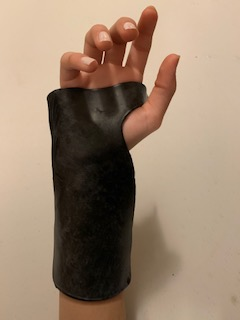After an injury, surgery, or onset of certain conditions, your doctor may ask you to see a hand therapist. Your prescription for therapy might include the need for a custom orthosis, commonly referred to as a brace or splint. A custom orthosis is a device that is molded to and worn on a specific body part. The device can help to protect and support bones, tendons, ligaments, nerves and keep these structures in safe and healthy positions. It can also be used to fix deformities or help people function better. It will be custom made specifically for you by your hand therapist.
Some of the reasons your doctor might prescribe a custom orthosis include:
- Arthritis
- Tendon injuries
- Broken bones
- Pain
- Burns
- Nerve injuries
Custom orthoses can be made from a variety of materials. One of the most common materials used is thermoplastic. Thermoplastic material is a low temperature plastic that starts out as a hard flat sheet. When the sheet of plastic is heated it becomes soft and pliable. This allows the material to be shaped and wrapped around the body part for a perfect fit. As the material cools, it becomes hard once again – like a cast.

After carefully reviewing the prescription from your doctor and completing an evaluation with you, the hand therapist will take measurements or tracings of the body part in need of the orthosis. The measurements or tracings are then transferred onto the flat sheet of thermoplastic material. The hard sheet is then put into a large pan of hot water. After a short time, the material is taken out of the water and is soft and flexible. While the material is soft the hand therapist will cut it into the shape of the measurements or tracing. Now it is ready to be wrapped and fit to you.

The hand therapist is specially trained in making custom orthoses. He or she will work carefully to provide a perfect fit. Edges of the material will be smoothed, pressure points will be eliminated, and the hand therapist will ask if the orthosis feels comfortable. Once it begins to harden and a comfortable fit has been achieved, Velcro straps are added to keep it in place. You may be asked to practice putting it on and removing it after it is made to ensure you are doing it properly.

You will be asked to let the hand therapist know if it gets uncomfortable or becomes too tight or too loose at any time. If this happens, the hand therapist will make adjustments. You will also be given information and instructions on the name and purpose of your orthosis, the times you should wear it, when you should take it off (if at all), and ways to clean and care for it. It is important to follow these instructions carefully so that you can make healthy progress and keep your orthosis in good condition.
Your therapist and doctor will let you know how long you will need to wear the orthosis. While an orthosis can be the right decision for a period of time, there may come a time when you no longer need the support, protection, or correction. Your therapist and doctor may recommend that you wear it less frequently and then stop wearing it altogether. Following these instructions will help get you closer to reaching your goals.
If you require assistance, please feel free to contact me, or make a booking online.
Article Reference: ASSH | Handcare
